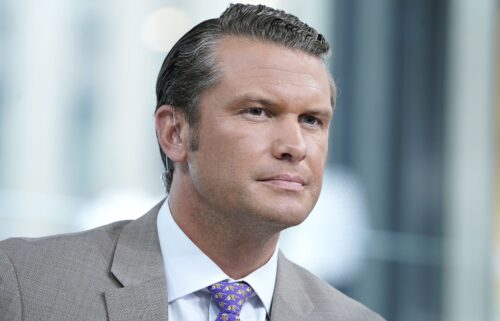Manchin thinks the child tax credit is too generous — but Republicans are responsible for that

By Tami Luhby, CNN
West Virginia Sen. Joe Manchin has lots of issues with the Democrats’ expanded child tax credit, which is a main reason why his party’s plan to extend it for another year is on ice.
One of his beefs is that higher-income families qualify for the credit — the final monthly payment of which was distributed in December.
“Do you believe people making $200,000 and $400,000 would still get the child tax credit the same as someone making $50,000, $60,000 or $70,000 that really needs it?” Manchin told West Virginia radio call-in show host Hoppy Kercheval in December, the day after announcing he could not support the current Build Back Better package.
But Manchin can’t blame his fellow Democrats for that income threshold. It was Republican lawmakers who drastically broadened the credit’s eligibility as part of their 2017 Tax Cuts and Jobs Act.
Republican tax cuts
Prior to the 2017 law, eligibility for the child tax credit began to phase out for single parents earning more than $75,000 and married parents making more than $110,000 a year.
Congressional Republicans temporarily raised those thresholds to $200,000 for single parents and $400,000 for married parents, as well as doubled the credit’s maximum size to $2,000 and made more lower-income families eligible. At the same time, GOP lawmakers temporarily eliminated personal exemptions and made other changes that offset much of the benefit for higher-income households.
The major motivation for the child tax credit changes, which are in effect through 2025, was to reduce people’s taxes, said Isabel Sawhill, a senior fellow at the Brookings Institution.
“It sounds like — even though I don’t think it’s true, especially at these higher income levels — that the money is going to be spent on children,” she said. “You’re just giving them more after-tax income, that’s all.”
Many experts feel that higher-income families shouldn’t receive a break like the child tax credit.
“People who make $300,000 or so just don’t need a tax cut of that size,” said Chuck Marr, senior director of federal tax policy at the left-leaning Center on Budget and Policy Priorities.
“It’s not well targeted, at all,” Sawhill said. “I don’t think anybody can reasonably argue that people with that level of income don’t have enough money to raise kids.”
More help for lower-income families
After taking control of the White House and Congress last year, the Democrats made several changes to the child tax credit aimed largely at helping lower-income and middle-class families.
As part of their $1.9 trillion coronavirus relief package, lawmakers increased the credit to a maximum of $3,600 for each child under age 6 and $3,000 for each one ages 6 through 17 for 2021.
The full credit was available for heads of households earning up to $112,500 a year and joint filers making up to $150,000, after which it began to phase out. Eligible higher-income parents still received the standard $2,000 credit.
Note: Manchin was incorrect that families making up to $70,000 got the same amount of child tax credit last year as those earning $200,000 or $400,000. The higher-income families received a smaller credit.
Also, more low-income parents became eligible for the full credit because lawmakers made it fully refundable. It had been only partially refundable — leaving more than 26 million children unable to get the entire credit because their families’ incomes were too low, according to Treasury Department estimates.
RELATED: Biden says he does not support adding a work requirement to the child tax credit
And Congress directed the Internal Revenue Service to deliver half the credit in monthly installments — up to $300 for each younger child and $250 for each older one — between July and December. Families can claim the other half when they file their 2021 taxes later this year.
The families of more than 60 million children received the monthly payments, which totaled nearly $93 billion.
Altogether, these changes were expected to reduce child poverty nearly in half, which President Joe Biden and congressional Democrats have repeatedly touted.
However, the enhancements were only in effect for one year. The Build Back Better package seeks to extend the beefed-up benefit for 2022 — although only those eligible for the full enhanced credit would receive the monthly payments. Also, it would make the credit fully refundable permanently.
Manchin’s concerns
For Manchin, however, the package’s current $1.75 trillion price tag is still too high, even though the Democrats already pared it back. The child tax credit portion would cost $185 billion, according to the Congressional Budget Office.
But the West Virginia senator is also concerned that the enhanced payments would be extended again because they’d be too popular to ax. Making the provisions permanent would cost $1.6 trillion over 10 years, the CBO estimated.
While Biden and Democratic leaders in the Senate are still hoping to move forward with the package, it could be difficult for them to reduce the price by excluding higher-income families from receiving the credit. That would go against the President’s pledge not to raise taxes on Americans earning less than $400,000 annually.
Lowering the thresholds could also create other problems, Elaine Maag, principal research associate at the Urban-Brookings Tax Policy Center, wrote in a blog post. Among them: It could reduce political support for the credit since it makes the benefit look more like a government assistance program, and it could lessen support from high-cost states, where incomes are generally greater.
“It is hard to argue that Congress should continue to provide CTC benefits to parents making $400,000,” wrote Maag, who suggested raising tax rates on higher-income Americans instead. “But lawmakers should think carefully about how low to set the new eligibility threshold and consider all the potential consequences of reducing it.”
The-CNN-Wire
™ & © 2022 Cable News Network, Inc., a WarnerMedia Company. All rights reserved.


